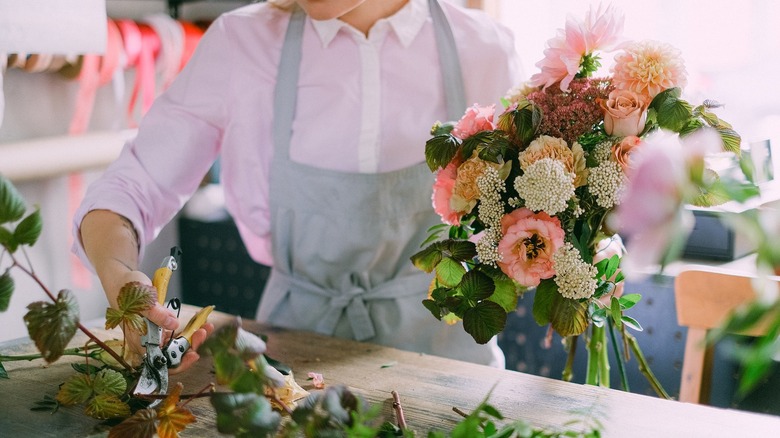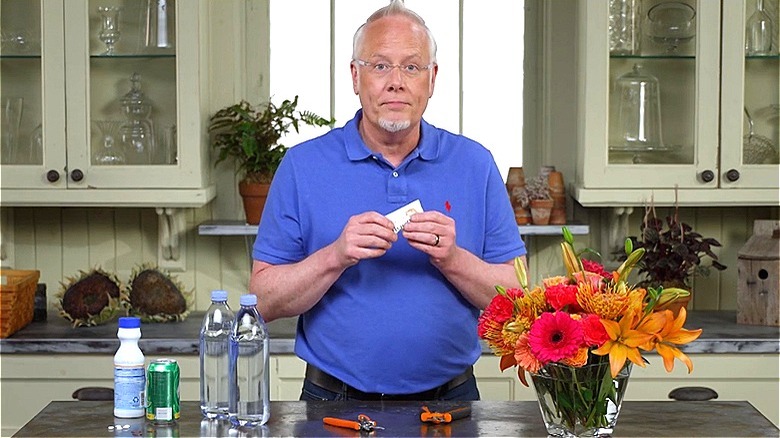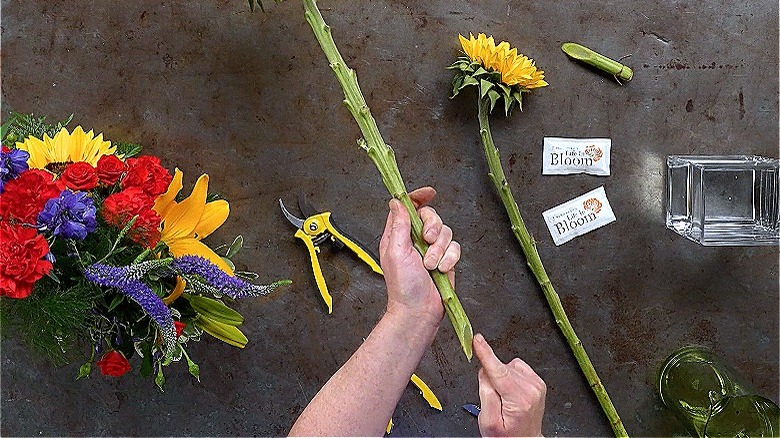J. Schwanke Explains Why The 'Food' Packet That Comes With Your Cut Flowers Can Make Them Last Longer
With store-bought flowers, you'll always find a little packet of "flower food" attached to the stems. While it can be tempting to just toss this packet in the trash and move on with arranging your new cut flowers, it turns out that you could be making a mistake that will affect the longevity of your blooms. According to well-known cut-flower expert and "Life in Bloom" host J. Schwanke, there are scientific reasons why the contents of that packet can make your floral arrangement last significantly longer.
As Schwanke explains, there are five key ingredients to the flower food packet that make flowers last for longer. These are sugar, a pH controller, an element to control bacteria, citric acid, and a "vasodilator." The sugar, he explains, is the actual flower "food" and what flowers need for their blooms to be larger and more colorful, as well as for their stems and leaves to remain green.
The pH controller, meanwhile, sets an ideal acidic level for the flowers to be happy, similar to how you would manage chemicals in a swimming pool. As Schwanke noted in Episode 401 of "Life in Bloom," "Our flowers love a pH level between 3.5 and 4.5." Like pool water, flower food contains chlorine, but unlike bleach or other options, the flower food packet's chlorine is time-released so it maintains an even level of acid for approximately three days.
The ingredients keep your stems healthy
Along with giving them food and the right acidic environment, the other ingredients in flower food packets are just as important in keeping your cut flowers blooming for as long as possible. For example, the bacteria controller in flower food does exactly what you think it would. Like an antibiotic for your flowers, it keeps any bacteria from growing in the water from the flower stems and making the water "cloudy."
Citric acid, the fourth ingredient, works in conjunction with the pH controller to maintain the acid level in the water. The stable acid levels also help to keep the flowers from wilting prematurely. And then the last item is a vasodilator, which is all about vessels. The flower stems have their own vessels, just like human veins. J. Schwanke compares the stem to a straw, noting "the water has to travel up that straw to the top of the flower."
The plant's photosynthesis — taking sun energy and making it into plant energy — basically works as an equivalent to muscle contractions in humans, in this case, drawing the water up through the plant. The vasodilator increases the size of the "straw," and thereby increases the amount of water it can absorb.
Cutting the stems correctly is also key
When it comes to arranging cut flowers, one of the most important steps that some people overlook is cutting the ends of the stems correctly. Per J. Schwanke, you want to cut your flowers at a 45-degree angle. He notes that as a professional florist, he prefers to work with a knife, but a sharp pair of scissors can do the trick, though he prefers what's called a bypass cutter or pruning shears. The reason for the angled cut is that it exposes a larger amount of the stem, which lets it draw in more of the nutrients present in the flower food-infused water. Conversely, a flat-cut stem will just rest on the bottom of the container, limiting how much nutrients the flower can absorb.
Along with his advice on using flower food packets, Schwanke also says that when your arrangement is done, you should place it out of direct sunlight, as that can wilt the plants. Also, you'll want to avoid placing them around ceiling fans, as the increased air circulation can cause the cut flowers to release their moisture and dry out. He also notes that cut flowers like ice-cold water, and advises against putting the stems in hot, or even lukewarm, water (both introduce more air).


